- Spain stay strong to seal second consecutive finals berth at the IHF Men’s Youth World Championship IHF
- Highlights of 11th IHF Men’s Youth World Championship 2025 in Cairo, Egypt Xinhua
- Spain, the winner of the last tournament, and Denmark, the runner-up, once again proved to be a stro.. 매일경제
- Spain deliver fantastic comeback against Egypt in record setting, Germany also makes semis at Egypt 2025 IHF
- Defending champion Spain came from behind to beat Croatia and confirmed their advance to the main ro.. 매일경제
Blog
-
Spain stay strong to seal second consecutive finals berth at the IHF Men's Youth World Championship – IHF
-

Half of Gen Z spends $0 a month on dating thanks to a ‘romance recession’
By Genna Contino
The pandemic changed dating for Generation Z. Economic pressures are making it even harder.
As the cost of living continues to rise and pandemic-fueled shifts in how people socialize linger, more than half of Gen Z is spending $0 monthly on dating, according to a Bank of America report.
For a demographic cohort facing a high cost of living, mounting student-loan debt and job-market instability, Generation Z has not been placing a high priority on dating. Instead, it’s a financial burden.
Data on spending habits provide a glimpse of how young folks’ mindset toward dating has shifted. About half of men (53%) and women (54%) ages 18 to 28 are spending $0 a month on dating, a recent Bank of America (BAC) report on Gen Z adults’ financial health found.
This is likely because Gen Z has a different approach to dating compared with prior generations when their members were in the age bracket Gen Z is in now, experts say. With pandemic-fueled changes to how people socialize, alongside economic pressures fueling a pullback in young people’s spending, dating has taken a backseat for a significant portion of Gen Z. Instead, many are prioritizing economic security before rushing to find a partner, get married, have kids and buy a home, compared with past generations, who typically hit those milestones earlier in life.
See more: TikTok’s latest budget hack is ‘dating for dinner’ – which says a lot about love and money right now
The Gen Z dating scene has been shaped by dating apps, social media and generative AI in ways that previous generations did not experience, while a period of forced isolation during the coronavirus pandemic exacerbated young people’s reliance on online connection, which in turn altered the way they connect. A 2024 Hinge report found that Gen Z is 50% more likely than millennials to wait to answer a message from a potential match to avoid seeming overzealous, and more than half (56%) surveyed said the fear of rejection has kept them from pursuing a potential relationship.
“We’ve seen a continual decline in dating. Some people are calling this the ‘romance recession’ or the ‘sex recession,’ particularly when we look at Gen Zs and you think of when they came of age, and dating and the pandemic hit within that,” said dating coach Damona Hoffman. “I see more people tapping out of the dating market entirely and just having anxiety about even stepping into the dating scene if they don’t have the money to date.”
Why is half of Gen Z not spending on dating?
About half of the Gen Z members surveyed by Bank of America said the high cost of living is a barrier to financial success. “They’re worried about groceries, worried about rent, worried about dining out,” said Will Smayda, head of financial centers at Bank of America.
And prices are still on the rise. At the core of the consumer-price index, an inflation reading that excludes food and energy prices and is a better predictor, prices were up 0.3% in July – the sharpest monthly increase since January.
See: Key inflation rate shows biggest rise in 6 months, CPI shows, but Fed rate cut still appears in play
Also: Americans more worried about inflation and unemployment after new trade deals leave tariffs at highest level in decades
Experts agree these growing financial hardships are making it hard for Gen Z to prioritize dating. And when members of the generation do decide to spend time and money on a date, they’re more deliberate with their choices.
“We’re seeing a shift toward intentional dating, especially among younger singles,” said Michael Kaye, director of brand marketing and communications for the dating app OkCupid. “Gen Z isn’t matching for instant gratification; they’re dating with purpose and prioritizing compatibility and shared values, over flashy spending.”
Some Gen Z-ers have chosen to tap out of the dating scene because of their own insecurities. Hoffman said she often comes across Gen Z singles who feel they are not “dateable” because of debt or a low-paying job, and a fear of being judged by potential partners keeps them from dating altogether.
However, data suggest that these fears may be unfounded: 68% of singles surveyed by OkCupid said they would date someone who makes significantly less than them, provided that person is driven or money is not a priority for them in a relationship. Gen Z and millennials made up 90% of the survey respondents.
People anxious about their own financial status and career might not realize that much of the dating pool is in the same boat, Hoffman said. And even if people think or say they’re looking for a partner who is rich, the person they end up connecting with might not fit that bill.
“What they say they want on a dating app or what they are kind of aspirationally going for in a match is not necessarily all they will date,” Hoffman said.
See more: Welcome to the real world, Class of 2025. Here are 5 money tips you haven’t heard a million times.
These money concerns tend to loom larger for singles when a relationship is still hypothetical, Hoffman added. “When you actually make that connection and they find some commonality, the financial piece usually is not front-loaded as much as it is when somebody is thinking about dating or planning to date.”
While these various stressors haven’t kept the entire generation from dating, they have made those who are dating more budget-conscious. Just under half of those surveyed by Bank of America said they are spending money on dating, with 28% of the total survey sample saying they spend less than $100 a month. Of the Gen Z-ers in a relationship, 43% of those not living together spent anywhere from $1 to $100 a month on dates, and 48% of cohabitating couples also fell in that range.
Gen Z’s postpandemic dating is different from generations prior
Along with financial pressures, the COVID-19 pandemic accelerated a trend of young people turning to online spaces for connection. While this sometimes meant engaging in solitary activities like binge-watching TV shows, it also led to a greater reliance on online communities to maintain social ties during quarantine. A Pew Research Center study, for example, found that adults under 30 were likeliest to say social-media sites helped them stay connected to friends and family during the pandemic.
For many young people who wanted to be out and about socializing and dating, this online connection was a lifeline. However, it created a stark contrast with previous generations, which relied on in-person gatherings and phone calls to form connections, using social media as a supplement to socializing rather than as a replacement, the Pew study suggests.
From the archives (April 2020): Online dating amid coronavirus: Longer conversations and a ‘pivot’ to video dates
Gen Z is also the first generation to come of age during the era of generative artificial intelligence, and while generative-AI companions are growing in popularity, their impact on dating is nuanced. A third of Gen Z singles have engaged with AI as a romantic companion, compared with 16% of all American singles, a 2025 study by Match Group (MTCH) in collaboration with the Kinsey Institute found.
“If you have Chad on your computer for free, why are you going to pay money to meet a real person who might reject you?” Hoffman said.
This trend toward AI companionship among singles, while notable, does not provide a full picture of Gen Z’s relationship with the technology. A broader 2024 Pew Research Center survey found that the majority of adults under 30 are mostly using generative AI tools for work, learning and entertainment, rather than for romantic purposes. So while the role of AI in dating is growing, research suggests it is not a mainstream replacement for human relationships.
Nonetheless, as Gen Z navigates evolving societal and economic pressures, a ripple effect is appearing: Dating is being delayed, which then pushes back major milestones such as marriage and homeownership.
Young adults are prioritizing economic security over having kids, Census Bureau data show, reflecting the rising cost of living. The S&P CoreLogic Case-Shiller national home-price index, which tracks U.S. residential real-estate prices, has nearly doubled over the past decade, while annual prices for child care ranged between $6,500 and $15,600 in 2022. The cost of tuition at a four-year public university increased 36.7% between 2010 and 2023, according to the Education Data Initiative.
See more: Home prices post smallest increase in nearly two years, Case-Shiller index says, offering buyers a reprieve
These rising prices have served as barriers for young people looking to settle down. In 1975, 45% of people ages 25 to 34 had moved out of the house, gotten married, had children and bought a home. In 2024, just 21% of people in this age group had reached all four of these milestones.
“Their milestones are not the same as their parents’ milestones,” Hoffman said. “The goalposts have moved.”
See: Biggest wholesale-prices jump in three years is clearest sign yet that Trump’s tariffs are costing Americans
Reframing a budget can help take the pressure off dating
One promising finding from the Bank of America report about Gen Z’s financial health is that 72% of the young people surveyed took steps to improve their financial health over the past year, including putting money toward savings (51%) or paying down debt (24%).
Gen Z-ers are also more straightforward than their older counterparts about their financial situation. They’re more likely to participate in “loud budgeting,” or openly share their budget strategies, said Smayda of Bank of America, and 42% in the report said they feel comfortable turning down a social outing if they can’t afford it.
From the archives (January 2024): ‘Loud budgeting’ is in for 2024, TikTok users say. It’s kind of a joke – but experts say it could help you.
(MORE TO FOLLOW) Dow Jones Newswires
08-15-25 1411ET
Copyright (c) 2025 Dow Jones & Company, Inc.
Continue Reading
-

TAR-200 Appears Highly Efficacious, Safe in BCG-Unresponsive NMIBC
Results from the SunRISe-1 trial showed that TAR-200 monotherapy achieved a complete response rate of 82.4% in patients with BCG-unresponsive NMIBC.
TAR-200 monotherapy elicited deep and durable responses with a tolerable safety profile in patients with Bacillus Calmette-Guérin (BCG)–unresponsive high-risk non-muscle invasive bladder cancer (NMIBC), as shown in results from the parallel-cohort phase 2b SunRISe-1 trial (NCT04640623) published in the Journal of Clinical Oncology.1
Patients in the trial were assigned to 4 cohorts: in cohort 1, patients received TAR-200 plus cetrelimab; in cohort 2, patients received TAR-200 monotherapy; in cohort 3, patients received cetrelimab monotherapy; and in cohort 4, patients with only high-risk papillary disease received TAR-200 monotherapy.
In all cohorts, TAR-200 was administered in a brief office procedure every 3 weeks through month 6, then every 12 weeks through month 24; cetrelimab was administered intravenously at 360 mg every 3 weeks through month 18. Treatment with TAR-200 and cetrelimab, respectively, was continued for up to 2 years and 18 months, or until confirmed high-risk disease persistence, recurrence, or progressive disease.
“Traditionally, these patients have had very limited treatment options. This new therapy is the most effective one reported to date for the most common form of bladder cancer,” stated lead study author Siamak Daneshmand, MD, director of Urologic Oncology with Keck Medicine of USC in a press release.2 “The findings of the clinical trial are a breakthrough in how certain types of bladder cancer might be treated, leading to improved outcomes and saved lives.”
In July 2025, the FDA granted priority review to TAR-200 in patients with BCG-unresponsive high-risk NMIBC.3
Cohort 2
In cohort 2, 85 patients with BCG-unresponsive carcinoma in situ (CIS) with or without papillary disease received TAR-200 monotherapy. The median patient age was 71 years, and the majority were male (80.0%) and White (87.1%). Additionally, 32.9% had concurrent papillary disease, 96.5% refused radical cystectomy, and 91.8% had a consistent modality of cystoscopy at baseline and post-baseline.
At the data cut-off of March 31, 2025, in cohort 2, the centrally-confirmed complete response (CR) rate was 82.4% (n = 70/85; 95% CI, 72.6%-89.8%); the investigator-assessed CR rate was 83.5% (95% CI, 73.9%-90.7%). The overall concordance between the centrally- and investigator-assessed CR rate was 95.0%. Notably, 96% of responses were achieved at first disease evaluation, with a median time to response of 2.8 months.
At 3, 6, and 12 months following treatment, the CR rates were 78.8% (95% CI, 68.6%-86.9%), 58.8% (95% CI, 47.6%-69.4%), and 45.9% (95% CI, 35.0%-57.0%). Subgroup analyses showed consistently high CR rates across all clinically relevant subgroups.
With a median follow-up of 20.2 months (range, 5.0-48.0) in responders, the median duration of response (DOR) was 25.8 months (95% CI, 8.3-not estimable); 52.9% of responders had a DOR of 12 months or more. The median time to cystectomy was NE, with 12- and 24-month radical cystectomy-free rates of 86.6% (95% CI, 76.6%-92.6%) and 75.5% (95% CI, 63.4%-84.1%).
The overall survival (OS) rates at 6 and 12 months were 98.7% (95% CI, 91.2%-99.8%) and 94.7% (95% CI, 86.5%-98.0%), respectively.
Regarding safety, treatment-related adverse events (TRAEs) occurred in 83.5% of patients; the most common were low-grade urinary tract events such as pollakiuria (43.5%), dysuria (40.0%), micturition urgency (24.7%), and urinary tract infection (UTI; 21.2%). Grade 3 or higher TRAEs occurred in 12.9% of patients, with the most common being urinary tract pain (4.7%). TRAEs led to dose interruption in 31.8% and treatment discontinuation in 3.5%.
Cohort 4
In cohort 4, 52 patients with BCG-unresponsive high-risk papillary disease-only NMIBC received TAR-200 monotherapy; 71.2% were male, 86.5% were White, and 69.2% were former or current users of nicotine.
With a median follow-up of 12.8 months (range, 4-17), the median disease-free survival (DFS) was NE; the 6-, 9-, and 12-month DFS rates were 85.3% (95% CI, 71.6%-92.7%), 81.1% (95% CI, 66.7%-89.7%), and 70.2% (95% CI, 51.6%-82.8%), respectively. The 12-month DFS rates were consistent in patients with high-grade Ta (70.0%) and T1 disease (72.2%).
TRAEs were reported in 80.8% of patients, most being lower urinary tract symptoms; grade 3 or higher TRAEs occurred in 13.5%, with the most common being bladder pain (3.8%). Serious TRAEs were sepsis, spinal fracture, and UTI occurring in one patient each. TAR-200 was discontinued due to TRAEs in 7.7%.
Cohort 1
In cohort 1, 53 patients with CIS with or without papillary disease received TAR-200 plus cetrelimab.
The centrally-confirmed CR rate was 67.9% (95% CI, 53.7%-80.1%), and the investigator-assessed CR rate was 83.0% (95% CI, 70.2%-91.9%). After a median follow-up of 33.4 months (range, 10.0-47.0), the median DOR was NE, the 12-month DOR rate was 76.3% (95% CI, 58.1%-87.4%), and 55.6% of patients remained in a CR. The 12-month OS rate was 98.0% (95% CI, 86.6%-99.7%).
TRAEs occurred in 92.5% of patients, with dysuria (30.2%) and pollakiuria (28.3%) being the most common. Grade 3 or higher TRAEs occurred in 37.7%, serious TRAEs occurred in 15.1%, and immune-related AEs occurred in 64.2%. TRAEs led to TAR-200 treatment discontinuation in 26.4% and cetrelimab discontinuation in 24.5%.
Cohort 3
In cohort 3, 28 patients with CIS with or without papillary disease received cetrelimab monotherapy.
The CR rate was 46.4% (95% CI, 27.5%-66.1%) via central assessment and 50.0% (95% CI, 30.6%-69.4%) via investigator assessment. With a median follow-up of 29.2 months (range, 11.0-45.0), the median DOR was 8.6 months (95% CI, 2.8-NE), the 12-month DOR rate was 38.5% (95% CI, 14.1%-62.8%), and the 12-month OS rate was 100% (95% CI, 100%-100%).
TRAEs occurred in 53.6% of patients, with the most common being pruritus (10.7%); grade 3 or higher TRAEs occurred in 7.1%. Serious TRAEs occurred in 3.6%, which was myopericarditis. Cetrelimab was discontinued due to TRAEs in 7.1%.
References
- Daneshmand S, Van der Heijden M, Jacob JM, et al. TAR-200 for bacillus Calmette-Guérin–unresponsive high-risk non–muscle-invasive bladder cancer: results from the phase IIb SunRISe-1 study. J Clin Oncol. Published online July 20, 2025. doi:10.1200/JCO-25-01651
- New treatment eliminates bladder cancer in 82% of patients. News release. Keck Medicine of USC. August 13, 2025. Accessed August 14, 2025. https://tinyurl.com/yeypdbzy
- Johnson & Johnson receives U.S. FDA Priority Review for TAR-200 NDA in high-risk non-muscle invasive bladder cancer. News release. Johnson & Johnson. July 17, 2025. Accessed August 14, 2025. https://tinyurl.com/4v6c4swz
Continue Reading
-

Replicating The Flyby Sampling Of Salty Ocean World Ice Grains Using Impact Ionization Mass Spectrometry
Analysis of exospheric ice grains at Europa by SUDA. In addition to analyzing any potential plume material, the Europa Clipper Surface Dust Analyzer (SUDA) investigation will detect (and potentially quantify) chemical species embedded in ice grains directly sourced from Europa’s surface by constraining their area of origin. Continuous micrometeroid bombardment lofts surface material into Europa’s exosphere, which will be analyzed directly by SUDA during flyby. Non-icy surface material is expected to be compositionally distinct from the nearly pure water ice material comprising Europa’s surface “background” (Top; noted as Type A detections and Type B detections, respectively). Using an ejecta cloud model coupled with SUDA’s ability to determine the velocity vector of impacting particles, the area from which each ice grain originated can be determined with a spatial resolution dependent on spacecraft altitude (15). A single Monte Carlo simulation for SUDA detections over chaos terrain during the sixth Europa flyby in the 19F23v2 tour design are shown (bottom). The left plot shows the origin of ice grains detected by SUDA; the right plot shows the simulated time sequence for these detections. C/A marks the point of closest approach. Tracing ice grain composition to an area on Europa’s surface will provide ground-truth measurements for interpreting remote sensing data and enable direct compositional measurements of Europa’s surface geology. Bottom images adapted with permission from ref. (16). Image credit: NASA/JPL-Caltech. — astro-ph.EP
The Europa Clipper mission will arrive at the Jovian system in 2030 and analyze ice grains sourced from the icy material on its surface using impact mass spectrometry, which will provide key constraints on Europa’s chemical composition and habitability.
However, deriving quantitative compositional information from spaceborne impact mass spectra of ice grains has historically proven difficult due to the confounding effects of composition and impact velocity, coupled with difficulties in accelerating ice grains to spacecraft velocities under analogous sampling conditions.
Using a novel hypervelocity ice grain acceleration and impact mass spectrometry method, we quantify the degree to which the mass spectra of NaCl-rich ice grains are influenced by chemical composition and impact velocity variations within the flyby velocity ranges planned for the Europa Clipper mission.
These results suggest that high-fidelity studies quantifying composition and velocity-related effects in impact mass spectra may be necessary to accurately interpret data collected at Europa and other ocean worlds in the future.
K. Marshall Seaton (1), Bryana L. Henderson (1), Sascha Kempf (2), Sarah E. Waller (1), Morgan E. C. Miller (1), Paul D. Asimow (3), Morgan L. Cable (1) ((1) Jet Propulsion Laboratory, California Institute of Technology, (2) Laboratory for Atmospheric and Space Physics, University of Colorado, Boulder, (3) Division of Geological and Planetary Sciences, California Institute of Technology)
Comments: 29 pages, 11 figures, 1 table
Subjects: Earth and Planetary Astrophysics (astro-ph.EP); Instrumentation and Methods for Astrophysics (astro-ph.IM); Space Physics (physics.space-ph)
Cite as: arXiv:2508.10169 [astro-ph.EP] (or arXiv:2508.10169v1 [astro-ph.EP] for this version)
https://doi.org/10.48550/arXiv.2508.10169
Focus to learn more
Submission history
From: Marshall Seaton
[v1] Wed, 13 Aug 2025 20:04:24 UTC (1,604 KB)
https://arxiv.org/abs/2508.10169
Astrobiology,Continue Reading
-
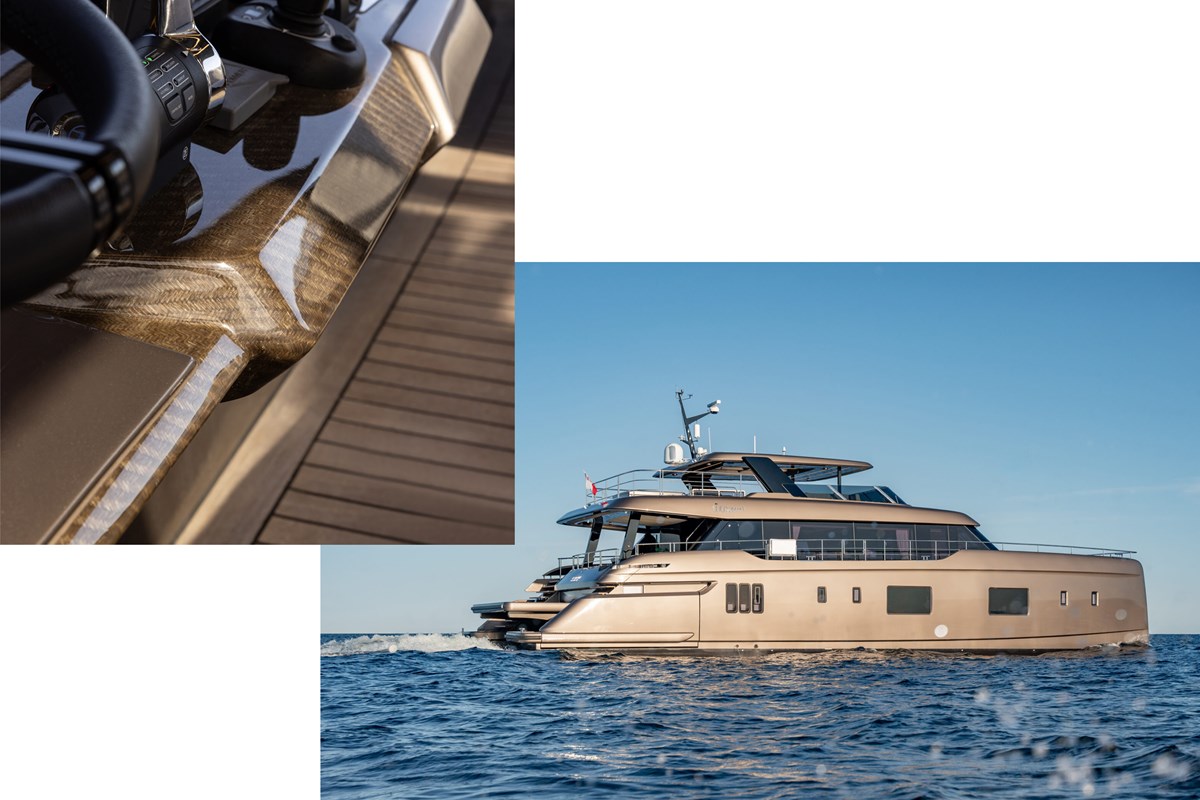
Bcomp natural fiber composites to enhance Sunreef catamarans
Source (All Images) | Sunreef Yachts
Bcomp (Fribourg, Switzerland) is collaborating with Sunreef Yachts (Gdańsk, Poland) to bring natural fiber composites into the interiors of the company’s latest power catamaran.

The forward section, bar, barbecue and navigation station of the 100 Sunreef Power will be built with Bcomp’s ampliTex material, which is made from flax fiber combined with bio-based or recyclable resin. Bcomp explains that this is a nontoxic, more sustainable and stiffer alternative to glass fiber, featuring vibration-damping properties that create a quieter and more comfortable interior experience for passengers.
These interior parts, says Bcomp, will impart durability with minimal environmental impact and feature an aesthetically striking pearl gray and charcoal color scheme.
Moreover, these natural fiber composites, adds Bcomp, help address the customization needs of each yacht customer, while helping marine manufacturers meet both sustainability goals and modern design expectations.
“Luxury should be redefined, not by excess but by conscious creation,” says Nicolas Lapp, CTO and co-founder at Sunreef. “Collaborating with Bcomp, a company that shares our commitment to innovation and environmental responsibility, enabled us to explore a new design language where natural materials elevate both aesthetics and performance of our interiors.”
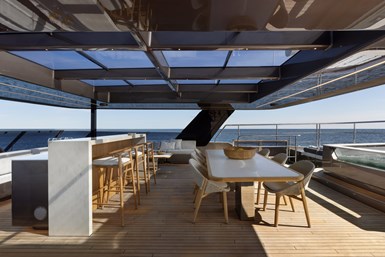
With sustainability and innovation at the core of both brands, this collaboration marks a strategic step for high-performance bio-based materials in the yachting sector and opens the door to expanded use of these technical fabrics for semi-structural catamaran parts.
“This project is a powerful example of what’s possible when it comes to sustainable yacht design” says Paolo Dassi, marine and industry manager at Bcomp. “By collaborating with Sunreef, we can establish bio-based composites as a staple in the customized design and construction of eco-catamarans.”
Bcomp’s natural fiber composites withstand the most extreme conditions, from Formula 1 seats to production sailboats, yachts and dinghies, as well as solar-powered ferries.
Continue Reading
-

iPhone 17 Pro’s physical SIM card slot purportedly shown in leaked images
The iPhone 17 Pro and Pro Max have recently been rumored to drop the physical SIM card slot altogether on a global scale, but today a new rumor comes to contradict this assertion.
A tipster over on X has shared the images you can see below, which purportedly depict the iPhone 17 Pro’s SIM card slot. Thus, the Pro and Pro Max will definitely still have a physical slot, at least in some markets. That is, of course, if this rumor pans out – we cannot independently verify that what we’re looking at here is indeed the iPhone 17 Pro’s SIM card slot. So, as usual, take all of this with a pinch of salt.

Purported iPhone 17 Pro SIM card slotThe iPhone 17 Pro is also rumored to start at 256GB of storage and sport repositioned antennas for better and more reliable reception. Its long-rumored redesigned camera island has most recently been confirmed by case maker dbrand.
The iPhone 17 family is expected to become official on September 9.
Source
Continue Reading
-
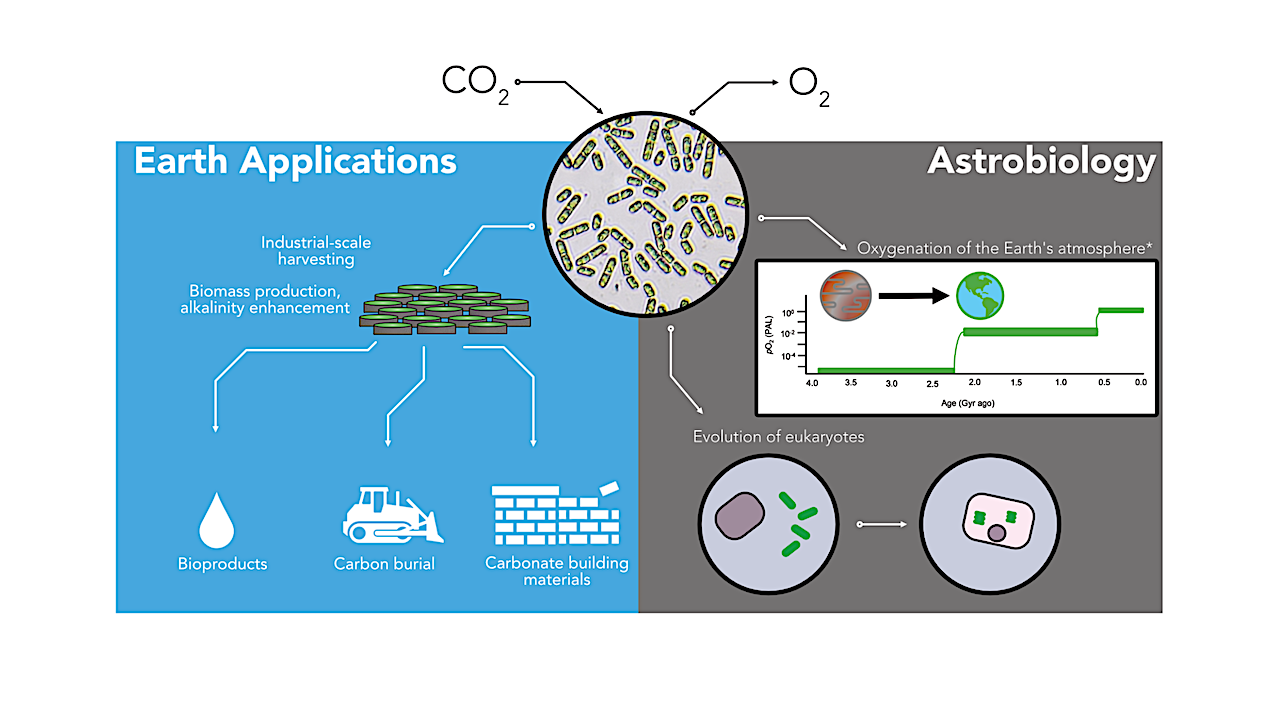
A Search for Life In The Universe Advances Life on Earth
Cyanobacteria as an example of astrobiology and biotechnology. Cyanobacteria fulfill two important roles in Earth habitability: the production of oxygen (right) and the fixation of carbon (from atmospheric carbon dioxide, left). Cyanobacteria are credited with significantly increasing global oxygen levels around 2.4 billion years ago, which shifted our planet’s redox conditions and could have spurred the evolution of eukaryotes and complex life. In the modern day, their voracious consumption of atmospheric carbon dioxide can be harnessed to again shift planetary-scale processes by sequestering carbon as biomass, carbonate, or biofuel products. — EarthRx
Astrobiology, while traditionally focused on understanding the origin of life on Earth and the potential for life elsewhere, offers powerful tools and insights for addressing urgent challenges on our planet.
This perspective, written by early career researchers, calls for a deliberate integration of astrobiological research with applied sciences in environmental engineering, biotechnology, and resource management. We highlight how knowledge from Earth analogs for other planetary bodies can inform strategies for carbon capture, low-carbon energy production, waste remediation, and biotechnology.
Examples include engineering serpentinizing systems for hydrogen and carbon sequestration, harnessing extremophile and cyanobacterial metabolisms for sustainable industrial processes, and applying microbial bioremediation to mitigate environmental contaminants and pollutants.
As technologies developed for space exploration begin to find terrestrial relevance, we argue that astrobiology must evolve to become a bidirectional science that not only explores the cosmos but also supports sustainable life on Earth. This dual approach strengthens our ability to design and implement astrobiological missions to other solar system bodies while simultaneously supporting improved stewardship of our own Earth.
Introduction
As early career researchers, we recognize an increasing tension between fundamental questions in science, such as “Where did life come from?” and “Does it exist elsewhere in our solar system and universe?” and pressing questions of environmental sustainability on Earth. We contend that these questions are not contradictory; instead, we among others increasingly observe investigations in fundamental, astrobiological questions intersecting with applied scientific fields, particularly in the realms of climate sustainability, biotechnology, and resource management.
Here, we propose a path that fosters synergy between Earth analog research and the application of biology and geochemistry of these natural systems to applied science. Given that astrobiology intersects heavily with multiple Earth-facing fields of study, this early career perspective argues that an Earth-centric approach to astrobiology can benefit both the field of astrobiology and the only planet known to harbor life: Earth.
Over the next two decades, we urge the astrobiology community, which conducts fundamental research on Earth in the search for life elsewhere, to advocate for and engage in translating our research in the aid of our own planet. We contend that there is significant motivation to reexamine and harness the extensive capabilities of microorganisms, and the analog environments they inhabit, to address the growing energy and resource demands of human life on Earth and potentially beyond.
In this perspective, we highlight several illustrative, but non-exhaustive examples of processes and themes that represent the convergence between astrobiology and applied science, including:
- Astrobiology and Environmental Science and Engineering: Investigating the interactions between biological and geological processes in analog environments to develop innovative solutions for energy production and carbon capture.
- Astrobiology and Biotechnology: Harnessing the unique capabilities of extremophiles and other environmentally relevant microorganisms to develop biotechnological applications that can address issues such as waste management, bioenergy production, and bioremediation.
- Astrobiology and Resource Management: Applying knowledge gained from studying microorganisms in analog environments to improve resource management practices on Earth, ensuring sustainable acquisition and use of natural resources.
Catherine G. Fontana1, Sabrina Elkassas, Tristan A. Caro, Srishti Kashyap, Alta E. G. Howells
A Search for Life in the Universe Advances Life on Earth, EarthArXiv
Astrobiology
Continue Reading
-
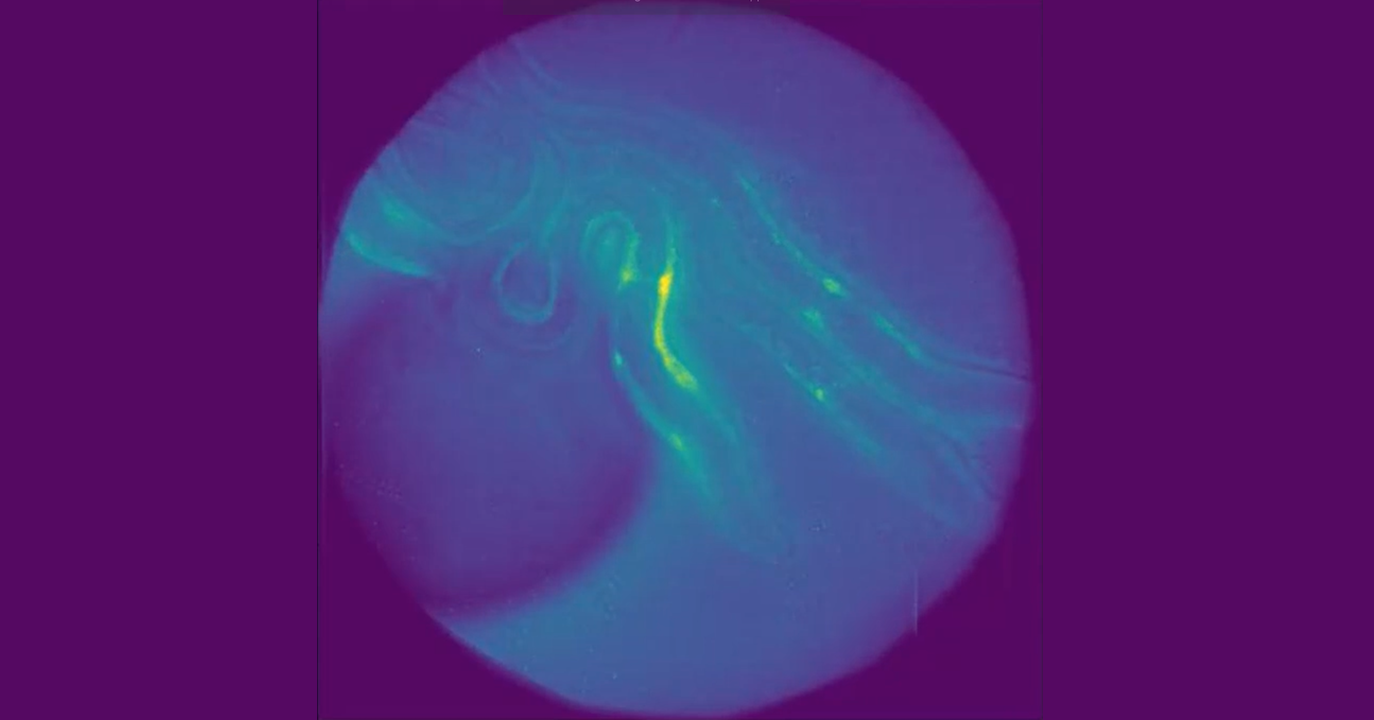
Tricorder Tech: Multifocus Microscope Pushes The Limits Of Fast Live 3D Biological Imaging
The M25 microscope, which can operate in fluorescence and transmitted light modes, can be used to watch the swimming of entire C. elegans worms, a model organism used to study development, neuroscience and aging. Credit Eduardo Hirata Miyasaki
Editor’s note: as we send increasingly sophisticated astrobiology probes – to more places – often at much greater distances – they will need to be able to do more and more analysis in situ i.e. onsite – without direct human assistance. When we eventually send human crews that will become even more important since the most needs to be made of the time they have to study the world they are visting. Being able to probe the inner workings of an alien ecology and its inhabitants will be crucial. Developments in imaging technology such as this one help pave the way toward those capabilities.
Researchers have developed a high-speed 3D imaging microscope that can capture detailed cell dynamics of an entire small whole organism at once. The ability to image 3D changes in real time over a large field of view could lead to new insights in developmental biology and neuroscience.
“Traditional microscopes are constrained by how quickly they can refocus or scan through different depths, which makes it difficult to capture fast, 3D biological processes without distortion or missing information,” said Eduardo Hirata Miyasaki, who performed the work while in Sara Abrahamsson’s lab at the University of California Santa Cruz (UCSC) and is now at the Chan Zuckerberg Biohub. “Our new system extends the multifocus microscopy (MFM) technique Abrahamsson developed by using a 25-camera array to push the limits of speed and volumetric imaging. This leap in efficiency opens the door to studying small living systems in motion without disrupting them.”
In Optica, Optica Publishing Group’s journal for high-impact research, the researchers describe their new microscope, which combines diffractive optics with 25 tiny cameras to synchronously and simultaneously image at multiple depths. They demonstrate live imaging of 25-plane 3D volumes measuring up to 180 x 180 x 50 microns at acquisition speeds of more than 100 volumes per second.
“The new microscope, which we call the M25, is particularly useful for imaging swimming C. elegans worms, a model organism used to study development, neuroscience and locomotion,” said Hirata Miyasaki. “Traditionally, scientists could only see part of the organism clearly at any one time. With our new microscope, it is possible to watch the entire worm move naturally in 3D, allowing researchers to study how its nervous system controls movement and how behavior might change in response to a genetic mutation, disease or drug treatment.”
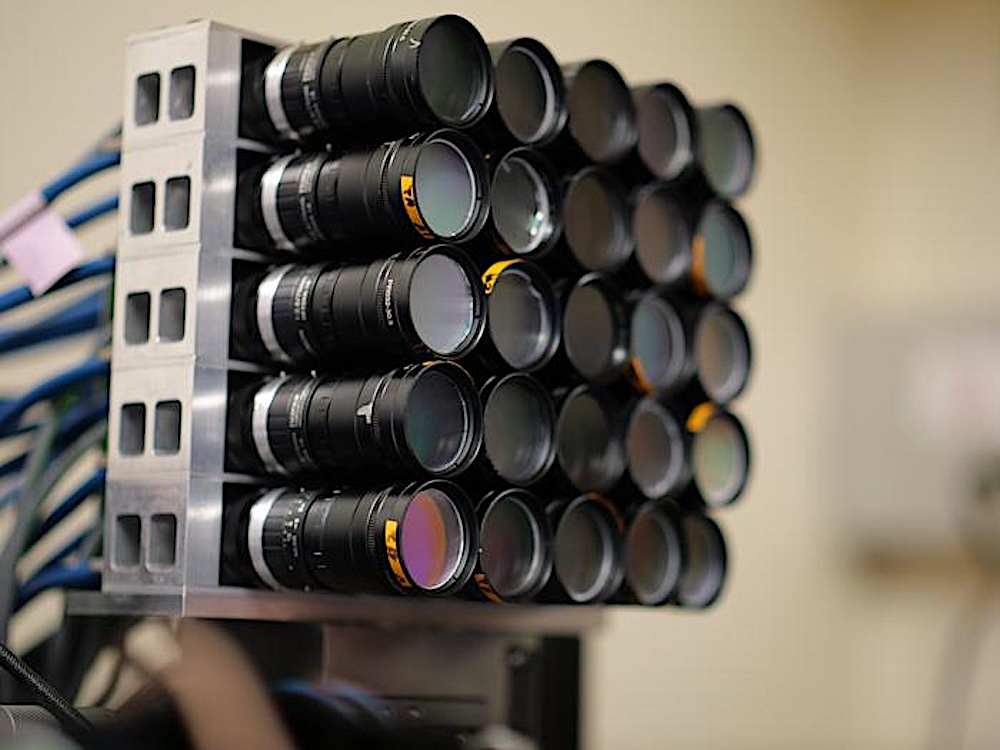
Researchers developed a new microscope that combines diffractive optics with 25 tiny cameras (pictured) to simultaneously image at multiple depths. Credit Eduardo Hirata Miyasaki
Multi-plane light control
A key part of the new microscope is the diffractive optical elements used to distribute the various focal planes across an array of 25 cameras. Diffractive optics use microstructures to manipulate light, allowing more complex light control via a thinner, lighter component than traditional optical components such as prisms.
Building upon the original MFM technique, the researchers designed a multi-focus grating to split the incoming light so that each camera captures the same scene but with a focus at a different depth. They also made customized gratings to use in front of each camera lens to correct the chromatic dispersion introduced by the multi-focus grating. By replacing the traditional chromatic-correcting prism, which was difficult to scale beyond 3×3 arrays, these blazed gratings enabled high-resolution, high-speed bioimaging across more planes.
The gratings are made from nanometer-scale patterns that require specialized fabrication tools. After using simulations to determine the optimal designs, the researchers used the University of California Santa Barbara nanofabrication facility to etch the patterns into glass. With the fabrication process now established, these diffractive elements can be accurately reproduced at higher volumes.
“One of the key innovations of the M25 is its use of simplified chromatic correction architecture: By replacing bulky prism-based components with custom-designed blazed gratings, the system achieves efficient dispersion correction across all focal planes while remaining compact and scalable,” said Abrahamsson. “This streamlined optical design not only enables high-speed imaging but also supports compatibility with label-free modalities — a major advantage for applications like embryology, where minimally invasive imaging is essential.”
The researchers also developed new software to handle the challenge of quickly synchronizing and acquiring data from 25 different cameras simultaneously and storing it in a computer.
“When combined, the 25 images — all acquired simultaneously, with no mechanical scanning or moving parts — form a complete 3D snapshot,” said Hirata Miyasaki. “Because this happens at high speed, limited only by the camera’s acquisition speed and the sample’s brightness, we can record entire volumes over time, enabling studies of real biological dynamics.”
Accessible and versatile imaging
The M25 microscope can be used for both fluorescence and label-free modalities, such as brightfield and polarization microscopy, which are especially useful for imaging sensitive biological systems without introducing dyes or labels. This compatibility with minimally invasive techniques makes the M25 well-suited for applications like embryology, where preserving native physiology is critical.
To validate the instrument, the researchers built a prototype and confirmed that it could capture 25 distinct, evenly spaced focal planes simultaneously, without distortion or overlap, by imaging calibration targets. They also used the microscope to image live biological specimens, including common model organisms such as C. elegans, D. melanogaster and P. marinus, demonstrating real-time 3D imaging of moving organisms without the need for scanning or motion compensation.
The system mounts to the side port of a standard commercial microscope. Aside from the diffractive optics, it requires no specialized hardware, making it more straightforward to replicate than systems that rely on custom prisms or complex light path modifications.
Detailed fabrication steps for manufacturing the chromatic correction blazed gratings and the multifocus gratings used in the M25 3D imaging system are available at https://zenodo.org/records/15522415. These components can be fabricated at any academic nanofabrication facility, including the UCSB Nanofabrication facility. The acquisition engine and napari plugin are available at https://github.com/SaraLab-Group/m25-napari and https://github.com/SaraLab-Group/m25-napari/tree/.
Next, the researchers aim to further expand the system’s scale and applications. For example, they plan to use the system’s rich imaging data to train machine learning models that can identify cell states, track dynamic behaviors and detect disease-related changes directly from images.
Paper: E. Hirata Miyasaki, A. Bajor, G. M. Pettersson, M. L. Senftleben, K. E. Fouke, T.G.W. Graham, D. D. John, J. R. Morgan, G. Haspel, S. Abrahamsson, “High-speed 3D Imaging with 25-Camera Multifocus Microscope,” 12, 1230-1241 (2025).
DOI: 10.1364/OPTICA.563617.
Astrobiology, Tricorder,
Continue Reading
-
Megadeth to end four-decade run with final album, farewell tour – San Francisco Chronicle
- Megadeth to end four-decade run with final album, farewell tour San Francisco Chronicle
- Megadeth Announce Final Album and Farewell Tour Variety
- Who Is Dave Mustaine? Megadeth Founder, Metal Icon, Cancer Survivor, Married For 34 Years, Dad Of 2 BollywoodShaadis
- Legendary Metal Band Launches Mysterious Countdown parade.com
- Megadeth announce retirement The Business Standard
Continue Reading
-
‘Subway Surfers’ and ‘8 Ball Pool’ to Release First In-Game Mobile Crossover Event – License Global
- ‘Subway Surfers’ and ‘8 Ball Pool’ to Release First In-Game Mobile Crossover Event License Global
- Subway Surfers to team up with Miniclip’s other hit 8-Ball Pool for first time Pocket Gamer
- ‘Subway Surfers’ Teams Up with ‘8 Ball Pool’ for In-Game Crossover Event The Toy Book
- Subway Surfers and 8 Ball Pool unite for their first-ever crossover event PocketGamer.biz
Continue Reading